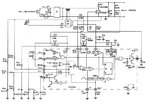ivan_mateo
Member level 1

Hi everyone,
I am planning to design a not complicated PFC circuit and started from understanding of UC3854 inside block diyagram, working princible. But I can not figure how to some structure. As you can see in the below, pin8 connect to AC line and detect input signal after that it square the signal and connect multipler. Also, multiplier has other pins that pin6 and pin11. And this multiplier doing I=A.B/C. I stuck in there, what is the purpose of multiplier?

I am planning to design a not complicated PFC circuit and started from understanding of UC3854 inside block diyagram, working princible. But I can not figure how to some structure. As you can see in the below, pin8 connect to AC line and detect input signal after that it square the signal and connect multipler. Also, multiplier has other pins that pin6 and pin11. And this multiplier doing I=A.B/C. I stuck in there, what is the purpose of multiplier?



